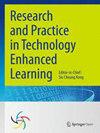小学应急电子学习的教学特点是什么?从教师、学生和家长的角度对学习活动的分析进行交叉核对
IF 3
Q1 EDUCATION & EDUCATIONAL RESEARCH
Research and Practice in Technology Enhanced Learning
Pub Date : 2023-03-08
DOI:10.58459/rptel.2023.18038
引用次数: 0
摘要
本研究考察了小学应急在线学习的教学特点。该研究增加了教育技术文献,通过从教师、学生和家长的角度对学习活动进行三角分析,探索学生的机遇和挑战。对22名教师、21名学生和10名家长的访谈进行主题分析,得出913条陈述,分为类别和子类别。此外,基于结合SAMR和协作模型的最新e-CSAMR框架,对93项学习活动进行了分析。参与者报告了学生独立性、责任感和学习自主性的发展,而消极地提到了与社会脱节和缺乏社会沟通的感觉。然而,对学习活动的分析主要反映了原始SAMR模型的基本水平,而不是先进的技术-教学水平,并表明它们没有充分地纳入协作活动或学习工件的设计。理论影响支持e-CSAMR框架,并确定了框架内应急学习的最佳组成部分。研究结果强调了将协作学习整合到远程在线学习中的必要性,并表明适当的支持和培训可以将挑战转化为教学机会。本文章由计算机程序翻译,如有差异,请以英文原文为准。
What are the pedagogical characteristics of elementary emergency e-learning? Crosschecking learning activities' analysis with perspectives of teachers, students and parents
This research examined the pedagogical characteristics of emergency online learning in elementary schools. The study adds to the educational technology literature, exploring the opportunities and challenges for students by triangulating analysis of learning activities with perspectives of teachers, students, and parents. Thematic analysis of the interviews with 22 teachers, 21 students, and 10 parents revealed 913 statements grouped into categories and subcategories. Furthermore, 93 learning activities were analyzed based on the recent e-CSAMR framework that combines the SAMR and collaboration models. Participants reported development of student independence, responsibility, and learning autonomy, while adversely mentioned feelings of disconnection and lack of social communication. However, analysis of learning activities reflected mostly basic rather than advanced techno-pedagogical levels of the original SAMR model and revealed that they did not sufficiently incorporate collaborative activities or design of learning artifacts. Theoretical implications supported the e-CSAMR framework and identified optimal components for emergency learning within the framework. The results highlight the need to integrate collaborative learning into distance online learning and suggest that appropriate support and training can transform challenges into pedagogical opportunities.
求助全文
通过发布文献求助,成功后即可免费获取论文全文。
去求助
来源期刊

Research and Practice in Technology Enhanced Learning
Social Sciences-Education
CiteScore
7.10
自引率
3.10%
发文量
28
审稿时长
13 weeks
 求助内容:
求助内容: 应助结果提醒方式:
应助结果提醒方式:


